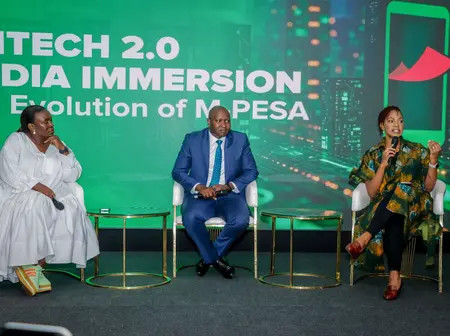Nairobi, Kenya: Forget wallets. Forget ATMs. In Kenya, the currency of the future is already in the palm of your hand. It’s not a credit card or a crypto-token—it’s a text message. This is the legacy of M-PESA, the mobile money miracle that exploded onto the global stage years ago on CBS’s 60 Minutes. What began in 2007 as a radical idea—that a phone could replace cash—has become the very bloodstream of the economy. From a buzzing Nairobi café selling a cup of tea to a boda boda rider in a remote village, cash is no longer king. The kingdom now runs on M-PESA.
The true value of M-PESA goes far beyond convenience. With cash, you risk theft, long queues at the bank, or the frustration of exact change. With M-PESA, money moves instantly and securely, a lifeline in emergencies, a bridge for families, and a tool for small businesses to thrive.
And now, nearly two decades later, Safaricom is rewriting the story with Fintech 2.0, the biggest upgrade to M-PESA in a decade. Just like the first time it transformed money in Kenya, this leap promises to reshape how people secure and scale their financial lives in the digital era.
Just like the first time M-PESA transformed how Kenyans exchanged money, this new leap promises to reshape how they secure, scale, and safeguard their financial lives in the digital era.
Safaricom CEO Dr. Peter Ndegwa doesn’t just see Fintech 2.0 as another system upgrade; he frames it as a turning point. “This upgrade is a bold investment in the future of M-PESA and a reaffirmation of our commitment to innovation, resilience, and customer trust,” he said. “By moving to Fintech 2.0, we are unlocking a platform that not only scales to meet today’s demands but also anticipates tomorrow’s opportunities.”
The Heart of Fintech 2.0
Safaricom calls it a next-generation M-PESA core platform. What that means for ordinary Kenyans is simple: a faster, safer, and smarter system. Here’s how:
🔹 Stronger Resilience – M-PESA will now run across multiple hosting sites. Think of it like having several power stations instead of one; if one goes down, the others keep the lights on. For users, this means fewer interruptions.
🔹 More Capacity – Until now, M-PESA could handle 4,500 transactions per second. Fintech 2.0 raises that to 6,000, with room to grow to 12,000. Imagine payday or Christmas, when everyone is sending money, transactions will still go through without delays.
🔹 AI-Powered Security – Fraud has been one of M-PESA’s biggest headaches, with SIM swap scams costing Kenyans millions. The new system uses artificial intelligence to detect suspicious activity instantly, block it, and even “heal itself” when problems arise.
🔹 Cloud-Native Foundation – This simply means Safaricom can launch new services faster and scale them instantly. So when Kenyans demand new products, they won’t have to wait for months of technical work.
Recently, Kenyans have voiced frustrations over M-PESA downtimes and rising cases of SIM-swap fraud reminders that even the most trusted platforms are not immune to setbacks. Safaricom acknowledges these concerns, noting that the recent outages were tied to the migration process itself: short-term disruptions for what they describe as long-term stability.
With Fintech 2.0, the company promises stronger security features to curb fraud, a more resilient system to minimize interruptions, and faster transaction speeds to restore confidence among its millions of daily users.
One may ask, why is this new innovation such a big deal for Kenyans? M-PESA is more than just a payment platform; it is the heartbeat of Kenya’s economy. In 2006, only 26% of Kenyan adults had access to formal financial services. By 2021, that number had soared to over 83%, thanks largely to M-PESA.
And the impact goes far beyond convenience. Studies show that mobile money contributes a notable share to Kenya’s GDP, powering trade in both the formal and informal sectors.
Picture this: a small kiosk in Gikomba market now pays suppliers through M-PESA instead of juggling wads of cash. A university student in Nairobi can receive school fees from relatives abroad within seconds. A farmer in Nyeri no longer needs to travel miles to a bank just to buy seeds.
Fintech 2.0 is what will keep these everyday stories alive with less downtime, faster transactions, and stronger protection against fraud.
Fintech 2.0 may be Kenya’s next chapter, but the story of mobile money is no longer confined within its borders. Kenya may have pioneered the idea, yet the ripple effects are being felt across the continent.
In Ghana, MTN Mobile Money has become central to trade, helping farmers and traders transact without cash. In Nigeria, startups like Flutterwave and Paystack are connecting African businesses to global payment systems, while in South Africa, digital wallets are steadily blending into traditional banking.
At the heart of all this progress lies a simple truth: technology alone is never enough it must be trusted. Fintech 2.0 is not simply a technical upgrade. It is about safeguarding the trust Kenyans have in M-PESA, ensuring the boda rider, the kiosk owner, the farmer, and the student can transact safely and quickly.
When the world looks at Africa’s digital transformation, M-PESA is often the headline. With this upgrade, Kenya is not only keeping its place at the front of the story it is writing the next chapter.
M-PESA Fintech 2.0 is not about replacing cash. It’s about making sure every Kenyan, and every African, can move money as easily as sending a text. And in that simplicity lies Africa’s greatest digital revolution.

Leave a Reply